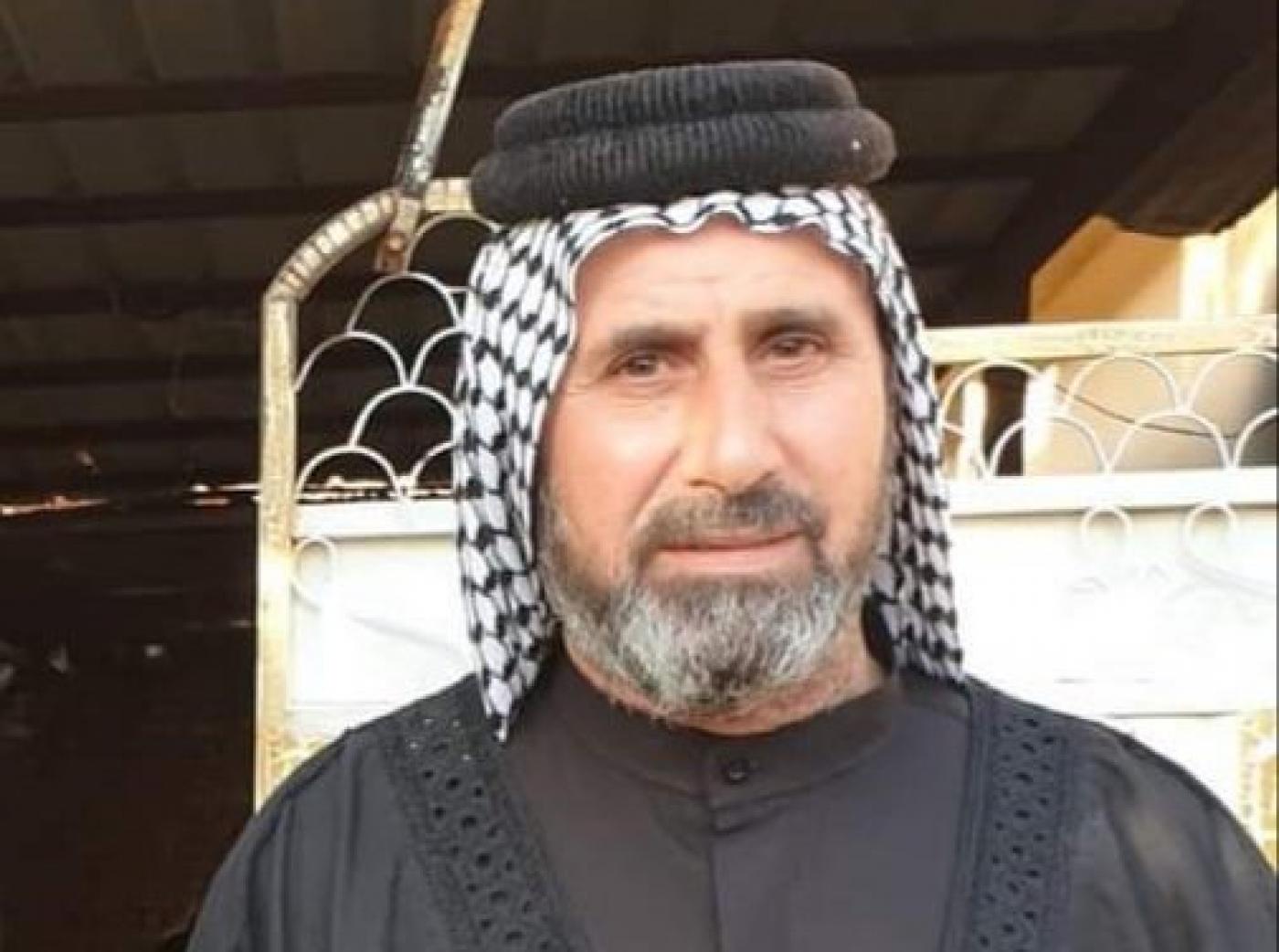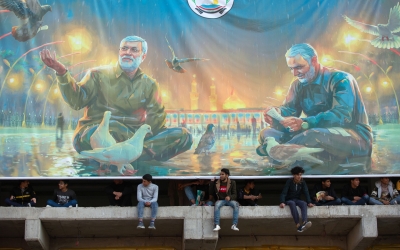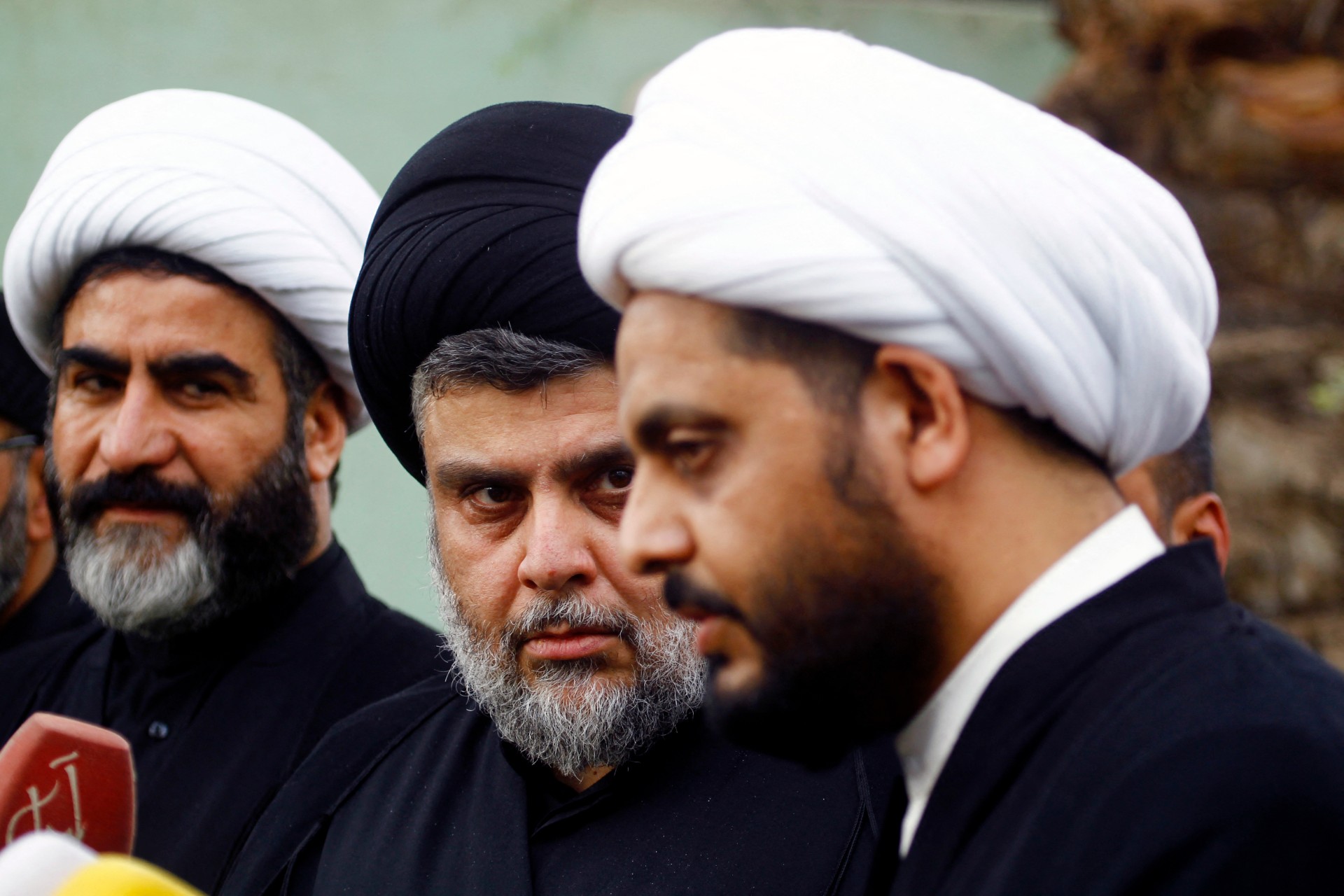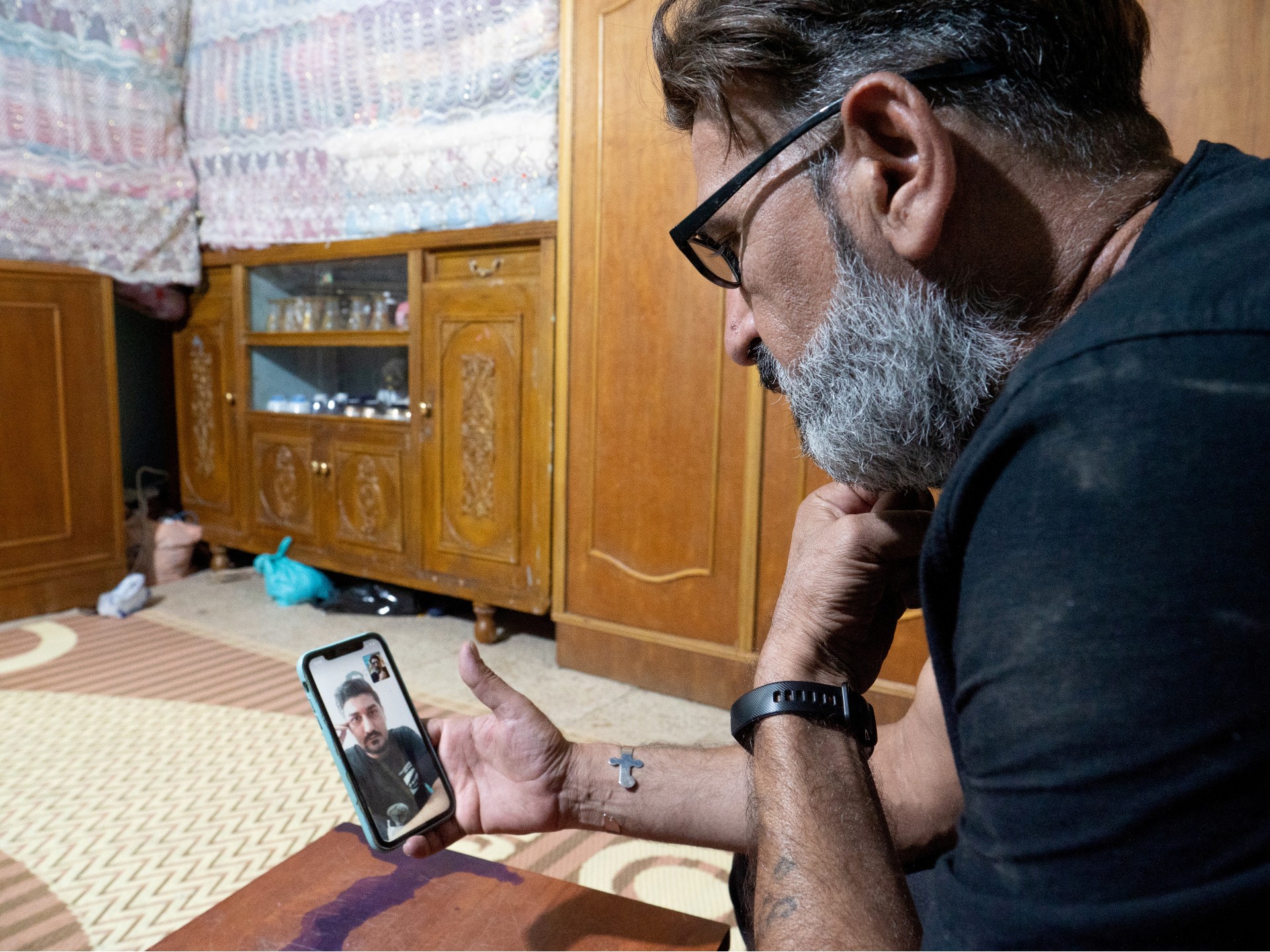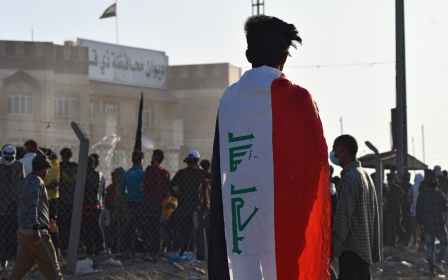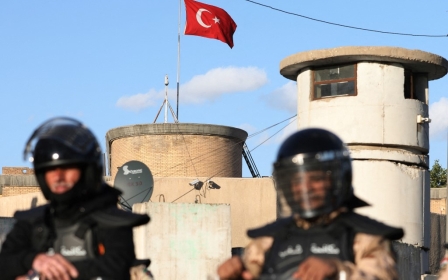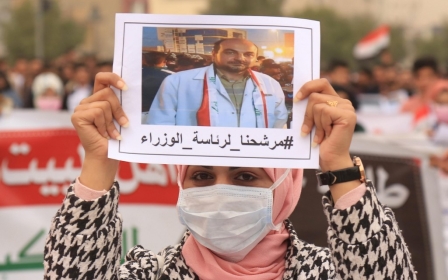In south Iraq, political murders are dismissed as 'personal' to quash investigations

Jaseb Hattab al-Hiliji never noticed the motorbike carrying two young men. It was just another bike, squeezing between pedestrians in the crowded, narrow streets of Amara's al-Sinaaiyah district.
Hiliji didn't notice either, when one of the men got off and walked slowly but purposefully towards him.
According to eyewitnesses, that is when the man took out a gun, pointed it at Hiliji's head and fired a bullet that silenced the 57-year-old forever.
Less than an hour later, the local police announced that they had arrested the murderer, and that the crime was triggered by a tribal dispute.
"Hiliji is a cousin of the killer, and they had major disputes and mutual lawsuits. The killer made this clear in his confessions," a senior local police officer told Middle East Eye.
New MEE newsletter: Jerusalem Dispatch
Sign up to get the latest insights and analysis on Israel-Palestine, alongside Turkey Unpacked and other MEE newsletters
"The killer said that he was returning from work and he found Hiliji in front of him while passing through the al-Sinaaiyah area, so he took out his pistol and shot him dead."
Official statements and videotaped confessions by the killer were explicit: this was a non-political crime, a family dispute. But the exact nature of the dispute was never presented, nor why the killer carried a gun in the first place.
To many in the southern city of Amara and Iraq in general, there was a different story. Hiliji was the victim of an assassination epidemic.
And as with killings before, the motives given by the authorities just did not wash.
A son's disappearance
Hiliji's tragedy stretches back further, to 7 October 2019. That's when his son, lawyer Ali Jaseb Hattab al-Hiliji, received a phone call from a woman who said he had been assigned as her representative in a divorce case.
CCTV footage of that evening shows Ali waiting by his car in central Amara, when a woman in a black gown approached him. The footage shows him speaking to the woman, whose face cannot be seen, for several minutes before a black Chevrolet Tahoe stopped 10 metres from the two. Three masked men got out of the Tahoe and forced Ali to get into their car.
As the black Tahoe left, a modern Toyota pickup appeared. The woman voluntarily climbed into it. The pickup left behind the Tahoe.
Soon after Ali's disappearance, rumours began to fly that he was disappeared because of links to the October 2019 anti-government protest movement that was raging in Amara and across southern Iraq and Baghdad.
Yet according to several prominent activists in the city who spoke to MEE, Ali was not a demonstrator or an activist. He had, however, participated with a number of lawyers in defending some of the youths who had been arrested because of their participation in the 2019 anti-government demonstrations in its first week.
Activists said the rumours he was kidnapped because he supported the protesters were spread to place more pressure on authorities to release him, as the demonstrations were attracting worldwide attention.
In fact, the story had another, unreported side.
Hijili spent the 17 months between Ali's disappearance and his own death desperately and noisily seeking his son. For the last 13 of those, he had begun publicly accusing Haider al-Gharawi, the leader of Ansar Allah al-Awfiya, a small Shia armed faction, of kidnapping him.
Sources said that the woman who called Ali and later appeared in the CCTV recordings was one of Gharawi's ex-wives, and that the kidnapping was motivated by the fact that Hiliji "dared to sue Gharawi".
"No one knows much about these details because it concerns a woman who is said to be the second wife of Gharawi. She used Ali's services to obtain a passport for her after she separated from her husband," a former associate of Gharawi told MEE, on condition of anonymity.
"The information that I have indicates that Ali was killed and buried in one of the empty areas near the Iraqi-Iranian border. As for the woman, no one has heard of her since that day, and we do not know where she is now," he added.
"She might be killed, too."
The associate did not explicitly say that Gharawi killed the two, but indicated that he knew their fate "with certainty".
This same story with different small details was repeated dozens of times by Hiliji in his private and public meetings, according to activists, local officials and relatives who were contacted by MEE.
However, MEE was unable to verify its authenticity despite repeated attempts to contact Gharawi, one of his personal companions and his spokesman, Sheikh Adel al-Karaawi. Despite that, MEE sent written questions to Karaawi, which he has not responded to by the time of publication.
Closing the case
On 12 March, the Amara Investigation Court publicly announced it was closing the case on Hiliji's assassination, following the judicial approval of the suspect's confession.
Based on the confession, the court concluded that Hiliji was accusing the suspect of kidnapping his son, and that pressure led him to murder him.
Not mentioned by the court, and apparently not probed by the investigators, is the suspect's relationship with Gharawi.
'The crime took place due to family disputes, and the killer was arrested and confessed to his crime, and the matter is over'
- Senior local police officer
The suspect, whose confession was broadcast by local police, has since 2011 been an Ansar Allah al-Awfiya fighter, and even fought with the faction in Syria, two sources close to Gharawi told MEE.
"We are not aware of the killer's political or non-political affiliations. The investigations did not address this part," a senior local police officer told MEE.
"The crime took place due to family disputes, and the killer was arrested and confessed to his crime, and the matter is over.”
But the matter is not over for some.
Hijili's assassination, and the manner in which it was dealt with by the authorities, have highlighted a growing trend in southern Iraq, where tribal and personal reasons are attributed to killings that appear highly political in nature.
And the victims, more often than not, are activists, journalists and protesters who cross the wrong people.
A bloody chain of events
Amara, the capital of Maysan governorate, is a border city sat on the banks of the Tigris River, 320km southeast of Baghdad. Like most Iraqi border provinces, tribal concepts dominate life in Amara and the rest of Maysan's cities and towns.
It is one of the south's largest strongholds of Sadrists, followers of the Shia cleric Muqtada al-Sadr. The Sadrists control the local government and most of the security departments associated with it.
For those looking to carry out illicit activities in Iraq, Amara is the perfect location.
It is one of the most important corridors used by criminal gangs smuggling weapons, drugs, antiquities and other contraband.
No wonder, then, that armed and political factions wrestle over its levers of power, sometimes with deadly results. And it was almost inevitable that the struggling youth protesting for a better future in October 2019 would collide with this bloody world, with terrifying consequences.
Early in the protest movement, demonstrators gathered around the headquarters of powerful paramilitaries and political parties, symbols of the forces that had grown rich at the expense of ordinary Iraqis.
Many were torched by protesters, and when hundreds began to move from Amara's main square towards the office of Asaib Ahl al-Haq on 25 October, the fearsome Shia paramilitary faction began to prepare for the worst.
Wissam al-Ellayawi, a prominent Asaib leader, was stationed at the top of the two-storey building with a group of his fighters. The demonstrators tried to storm the building, but Ellayawi and his men began firing in the air to drive them away, and later at their legs.
Suddenly, a group of fighters from Saraya al-Salam, Sadr's armed wing, appeared. They wore black suits and black hats, and were travelling in Toyota pickups, carrying Kalashnikovs, RPG-7 launchers and grenades, eyewitnesses told MEE.
The two sides clashed in a bloody battle that lasted four to five hours. Most of Ellayawi's men were killed, and the commander himself sustained a head wound from a hand grenade’s shrapnel.
Three Sadrist leaders in Amara intervened to evacuate Ellayawi, who along with his brother was transported to al-Sadr Hospital, where doctors insisted he needed to be treated.
That hospital, however, is adjacent to the square where thousands of protesters had massed.
As soon as the ambulance arrived there, a group of demonstrators attacked it, pulling Ellayawi and his brother out of it, killing them, then gouging out their eyes and mutilating their bodies.
Those events unleashed a bloody chain of events still being felt in the southern city.
A string of killings
The enmity between Sadr and Asaib Ahl al-Haq dates back to 2005 when Asaib's leader, Qais Khazali, defected from the Mahdi Army, which was then Sadr's armed wing, to found his own paramilitary force.
Asaib Ahl al-Haq attracted a large number of elite fighters who defected from the Mahdi Army, and ever since the two have occasionally exchanged bloody terminations.
'Our information confirmed that what happened to Ellayawi was planned, and any reaction from our men could have led to engaging in a losing battle with the Sadrists'
- A close associate of Khazali
Video footage taken by protesters and observers on 25 October suggest it was Sadrists who played a leading role in the violence that killed Ellayawi.
In the wake of the incident, Khazali, who has a reputation of being daring, confrontational and sly, ordered his men to retrieve and bury their comrades and "disappear completely from the scene until further notice," one of Khazali's close associates told MEE.
"Our information confirmed that what happened to Ellayawi was planned, and any reaction from our men could have led to engaging in a losing battle with the Sadrists," Khazali's associate said.
"Khazali's orders were clear and explicit: to leave everything immediately and leave Amara."
In response to Khazali's orders, most of his men left Amara that night, several sources told MEE. But the gates of hell were opened onto protesters and activists who were not even on the scene when the clashes and murders took place.
That November saw four assassination attempts against prominent activists linked to the demonstrations, two of which were successful.
Most notable, was the 6 November killing of Amjad al-Dahamat, who was seen as a mentor figure for many activists and protesters in Amara.
Dahamat and a number of his companions had just finished a meeting with the then police chief when he was intercepted by a black jeep as he left.
One of its occupants fired a torrent of bullets towards Dahamat, three of which downed him, with two others wounding fellow activist Bassam al-Saaidi, police and activists said.
A number of Sadrist leaders quickly provided activists with "detailed" information on the perpetrators, who they said were Asaib Ahl al-Haq fighters, and soon the public narrative roundly accused Khazali's men.
But developments on the ground were suggesting a different picture.
Few were buying the claims that the events of 25 October were the result of public anger, when two groups armed to the teeth engaged in clashes for hours while batting away attempts at mediation.
The possibility of intra-Shia conflict erupting that night put both Khazali and Sadr under great local and regional pressure.
Khazali, who was seen crying in public for the first time that night, took several steps back and pulled his men out of Amara "to avoid more bloody confrontations and a losing battle" with the "reckless" Sadrists who share their strongholds in all Shia-dominated areas and outnumber them, Khazali's associate told MEE.
For the people of Amara, those clashes opened up a raft of questions: with what authority were Sadr's followers stepping in instead of the security services? Was there really a need for their intervention? And was it really a matter of protecting the demonstrators, or was it an opportunity to settle scores with Ellayawi and Asaib?
'They began to openly attack us'
The November assassinations doubled the anger against Asaib Ahl al-Haq, and enshrined the idea that they are the number one enemy of the protesters in Amara.
Whoever carried out these assassinations had provided a very valuable service to Sadr's men in Amara, by relieving pressure on them from Sadr and justifying their intervention at the Asaib office as "support for the demonstrators". They also clipped the protesters' wings and tightened Sadrist control over them.
Were Asaib Ahl al-Haq, the Sadrists or a third party behind these assassinations? Police investigations have not settled the matter, but subsequent developments have answered some questions.
'What is really happening is a bloody struggle over power and influence, with an almost complete absence of desire to end bloodshed and resolve disputes through dialogue'
- senior police officer, Amara
After three months of demonstrating, the protest movement across Iraq had suffered the loss of dozens of its most prominent leaders, who had been killed, wounded, detained, kidnapped or fled.
In Amara, two young men had succeeded Dahamat as protest leaders: Abdul Quddus Qasim, a theatre actor, and Rida al-Aqili, coordinator of the student movement. Both succeeded in reviving the flame of protest in the city and keeping the people of Maysan on the streets.
In February 2020, Sadr used the nomination of Mohammed Tawfiq Allawi as prime minister to call for an end to the protests, and his supporters withdrew from the squares.
But the protesters rejected Allawi, as they refused Sadr's claim of guardianship over the protest squares, and launched mass demonstrations, chanting against the two men.
"This moment was the crossroads that we reached with the Sadrists, and they began to openly attack us everywhere," a prominent activist in Amara told MEE.
Qasim and Aqili, who publicly defied Sadr's orders, were the biggest obstacle the Sadrists faced as they tried to end the demonstrations in Amara, a number of activists told MEE from abroad, where they sought refuge about two years ago after their comrades were killed.
"Abdul-Quddus refused to leave Amara despite our insistence, and continued to criticise Sadr and his men in his Facebook posts and his conversations with the demonstrators," an activist said.
"Rida also did not remain silent and continued to criticise Sadr in his conversations with the media."
Qasim and his friend Karrar Adel were assassinated in the centre of Amara on 10 March 2020, while Aqili survived an assassination attempt two days later.
"What is really happening is a bloody struggle over power and influence, with an almost complete absence of desire to end bloodshed and resolve disputes through dialogue," a senior police officer in Amara told MEE.
"Weapons are everywhere and tribal customs are ruling, so how can we control a young man in his twenties, who owns an RPG 7 and enjoys full protection from his tribe and the faction to which he belongs?"
Mislabelled murders
There are no official statistics for the murders that each governorate witnesses monthly or annually, but a security development official told MEE that 11.5 of every 100,000 Iraqis are murdered every year.
According to unofficial statistics prepared for study and security development purposes and obtained by MEE, 2020 witnessed about 4,700 recorded murders, while the previous year saw 4,180. These statistics do not include non-criminally motivated or military crimes.
With seven assassinations since October 2019, Amara has the third-highest rate of murders targeting activists, protesters and journalists in Iraq, Ali al-Bayati, a member of the Iraqi High Commission for Human Rights, told MEE.
In Amara and another protest hotspot, Basra, a high number of murders are "intentionally" mislabelled as tribal-motivated killings, federal security officials told MEE.
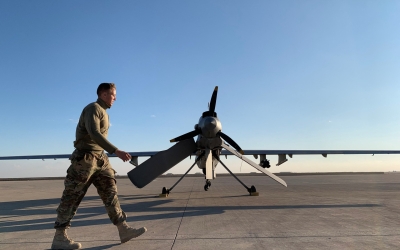
Manipulating the description of the crime and its real motives, and "avoiding mentioning everything related to the political and exclusivist character," speeds up the closure of investigations and provides a route for perpetrators and the parties that back them to escape punishment or fallout, local and federal security officials said.
After reviewing most assassination incidents recorded in the governorates of Amara, Basra, Nasiriyah and Diwaniyah since October 2019, and speaking to several intelligence and police officers, local and federal security officials and activists, Middle East Eye has found that dozens of murders were wrongly or dubiously recorded as politically motivated assassinations, regular criminal crimes or tribal-motivated ones.
"Investigation and intelligence officers do not conduct serious investigations when it comes to murder crimes involving political forces or armed factions. Once the investigation reaches this stage, it is closed," an intelligence officer serving in Nasiriyah told MEE.
"No officer dares to continue investigating the assassination crimes specifically. If he is lucky, he will be threatened and removed from his workplace, and if he is unlucky and he continues the investigation with or without intention, he will be killed," the officer added.
'Amara is a city completely hacked by the militias, and the local judiciary is shackled and unable to conduct professional and impartial investigations into such cases'
- Iraqi activist
"We all know this fact, and therefore these crimes are usually recorded against unknown persons or clan motives, and if they happen to have caught the killer in the act and are unable to release him, then his political affiliations or the party for which he is working in is not mentioned."
As for the Hiliji case, Prime Minister Mustafa al-Kadhimi's office intervened to have it transferred to authorities in Baghdad, "to ensure the safety and integrity of the investigation and that the militias do not interfere to divert the course of the investigation," one of Kadhimi's advisers said.
"Amara is a city completely hacked by the militias, and the local judiciary is shackled and unable to conduct professional and impartial investigations into such cases," a prominent activist, who follows the developments of the case with the Hiliji family, told the Middle East Eye.
"Moving the case to Baghdad means reopening the investigation away from pressure. We hope that the investigations will lead this time to the real killer."
Middle East Eye delivers independent and unrivalled coverage and analysis of the Middle East, North Africa and beyond. To learn more about republishing this content and the associated fees, please fill out this form. More about MEE can be found here.


